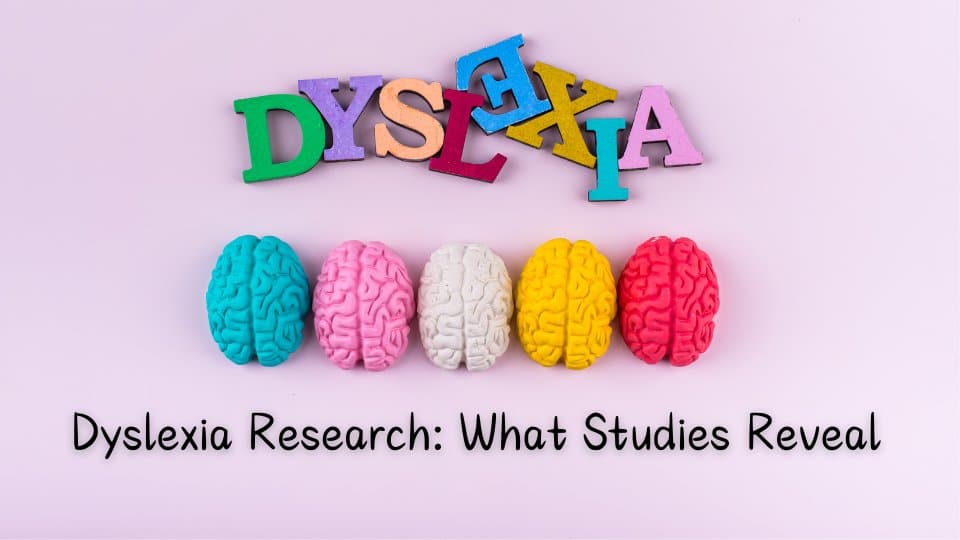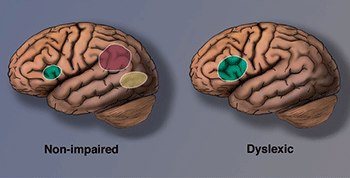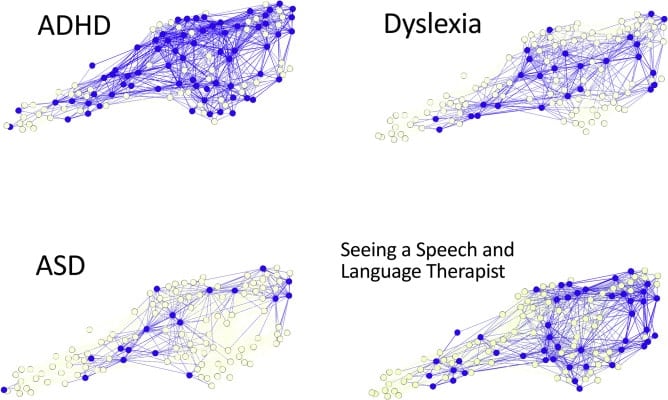
Dyslexia is a learning disability. People with dyslexia have trouble reading at a good pace and without mistakes. They may also have difficulties with reading comprehension, spelling, and writing.
Sounds simple? Not so.
Debates about the very existence of dyslexia have raged for many years — as well as the symptoms, possible causes, and best treatment. At first glance, this seems somewhat puzzling, as a fascination with unexpected reading problems in individuals with high intelligence and sound eyesight has been expressed for centuries. The topic has been extensively researched across a variety of disciplines, abounding with contradictory results.
Amidst the myriad uncertainties, we find solace in a handful of pivotal and groundbreaking studies on dyslexia research. These studies, despite the ongoing debates, have significantly advanced our understanding of this complex condition.
Table of contents:
- Dyslexia isn’t a matter of IQ
- Brain differences in dyslexic readers
- Poor connectivity in the brain
- Dyslexia linked to poor rapid naming
- Visual processing deficits are not rare
- Increased spacing helps, color overlays don’t
Dyslexia isn’t a matter of IQ
Traditionally, dyslexia has been defined in terms of a discrepancy between actual reading performance and what would be expected based on the child’s intelligence. The ‘true dyslexic’ was typically someone who, despite struggling with reading, is above average in intelligence (Elliott, 2015). When children are less intelligent, their reading troubles have been ascribed to their general intellectual limitations.
A study of brain scans found that children who are poor readers have the same brain difficulty in processing the sounds of language, whether they have a high or low IQ. Poor readers in both the dyslexia and low IQ groups showed significantly less brain activity in six observed areas than typical readers. However, there was no difference in the brains of the poor readers, regardless of their IQs (Tanaka et al., 2011). These findings were largely replicated by Simos et al. (2014).
Brain differences in dyslexic readers
There are structural and functional brain differences between people with dyslexia and typical readers. If these brain differences are the cause or the result of dyslexia is not conclusive.
In a meta-analysis of functional neuroimaging studies of dyslexia, Martin et al. (2016) list studies in which differences between groups with and without dyslexia were found in specific brain regions. The most consistent findings concerned the left occipitotemporal cortex, which includes the so-called visual word form area (VWFA), thought critical for reading.

Neuroscientists at Georgetown University Medical Center concluded that skilled readers can recognize words at a lightning-fast speed when they read because the words have been placed in a sort of visual dictionary. This part of the brain, the VWFA (shown in yellow), functions separately from an area that processes the sounds of written words (Glezer et al., 2016).
In the largest study of its kind up to date, Brem et al. (2020) confirmed that the VWFA is key to fluent reading.
The left inferior parietal lobule came in a close second in the meta-analysis study by Martin and colleagues (shown in red). This part of the brain is said to be involved in word analysis, grapheme-to-phoneme conversion, and general phonological and semantic processing.
Imaging also reveals compensatory overactivation in other parts of the reading system (shown in green). The compensatory neural systems allow a dyslexic person to read more accurately. However, the critical VWFA remains disrupted, and difficulties with rapid, fluent, automatic reading persist. The dyslexic continues to read slowly (Shaywitz, 2005).
Poor connectivity in the brain
According to a team of scientists at the MRC Cognition and Brain Sciences Unit, University of Cambridge, there are, in fact, no specific brain areas that cause learning disabilities, such as dyslexia (Siugzdaite et al., 2020).

The researchers found that the brain differences did not map onto any labels the children had been given — in other words, there were no brain regions that predicted having ADHD, dyslexia, or ASD (autism spectrum disorder). More surprisingly, they found that the different brain regions did not even predict specific cognitive difficulties — there was no specific brain deficit for language or memory difficulties, for example.
Instead, the team found that the children’s brains were organized around hubs, like an efficient traffic system or social network. Children with well-connected brain hubs had very specific cognitive difficulties, such as poor listening skills, or no cognitive difficulties. By contrast, children with poorly connected hubs — like a train station with few or poor connections — had widespread and severe cognitive problems.
Dyslexia linked to poor rapid naming
Research on rapid naming, or rapid automatized naming (RAN), began with the work of Denckla and Rudel. Rapid automatized naming (RAN) refers to the speed with which one can retrieve the names of symbols (letters, numbers, colors, or pictured objects) from long-term memory.
Dyslexia has been linked to poor rapid naming. However, there are considerable differences in the literature concerning the extent of this relationship. Some studies have reported a strong correlation between measures of RAN and reading, whereas others have found small or nonsignificant correlations.
Araújo and team (2015) analyzed data from 137 studies and found a moderate-to-strong relationship between RAN and reading performance. In fact, the meta-analysis demonstrated that RAN tasks have great potential for predicting reading ability. Further analyses revealed that RAN contributes to the four reading measures: word reading, text reading, non-word reading, and reading comprehension. Higher coefficients emerged in favor of real-word reading and text reading.
The data demonstrated that RAN significantly correlates with reading ability across languages that vary in orthographic consistency. The correlations for transparent orthographies were weaker than for opaque orthographies. In addition, this study revealed that RAN plays a vital role in learning to read regardless of whether the sample subjects used an alphabetic or non-alphabetic writing system, such as Chinese or Japanese.
Visual processing deficits are not rare
Until the 1950s, the belief was that dyslexia is attributable to visual processing problems. Visual processing refers to the brain’s ability to interpret visual information from the world around us.
Since then, the visual processing deficit theory has been abandoned as a cause of dyslexia, and the phonological deficit theory has become the Holy Grail. Phonemic awareness has become the “most important core and causal factor separating normal and disabled readers” (Adams, 1990). Phonemic awareness is a subset of phonological awareness that focuses on recognizing and manipulating phonemes, the smallest sound units.
Recent developments in dyslexia research have led some to conclude that all previous models based on a single deficit are inadequate. Studies show that visual processing deficits in dyslexia are not rare. The results of Georgiou et al.’s study (2012), for example, indicate that of the children with dyslexia:
- 0% (0 of 21) had an auditory processing deficit,
- 52% (11 of 21) had a visual processing deficit,
- 33% (7 of 21) had a phonological deficit,
- 52% (11 of 21) had a rapid naming deficit,
- 86% (18 of 21) had an orthographic processing deficit.
Increased spacing helps, color overlays don’t
Children with dyslexia can read faster and more accurately when letters in text are more widely spaced, showing an immediate improvement equal to a year’s worth of classroom instruction. This progress could stem from the fact that dyslexic children are susceptible to “perceptual crowding,” i.e., the visual masking of each individual letter by those surrounding it. The results of this study show that this crowding effect may be reduced by spacing letters apart (Zorzi et al., 2012).
Published in the journal Research in Developmental Disabilities, a study by Stagg and Kiss (2021) tested the effect of increased spacing between letters on dyslexic children and a comparison group of non-dyslexic children. Participants read four texts with either standard or extra-large letter spacing with or without a colored overlay. The dyslexic group showed a 13% increase in reading speed, while the comparison group of non-dyslexic children showed a 5% increase in reading speed. In contrast, colored overlays had no impact on reading speed.
Edublox offers cognitive training and live online tutoring to students with dyslexia, dysgraphia, dyscalculia, and other learning disabilities. Our students are in the United States, Canada, Australia, and elsewhere. Book a free consultation to discuss your child’s learning needs.
References:
Adams, M. (1990). Beginning to read: Thinking and learning about print. Cambridge, MA: MIT Press.
Araújo, S., Reis, A., Petersson, K. M., & Faísca, L. (2015). Rapid automatized naming and reading performance: A meta-analysis. Journal of Educational Psychology, 107(3): 868–83.
Brem, S., Maurer, U., Kronbichler, M. et al. (2020). Visual word form processing deficits driven by severity of reading impairments in children with developmental dyslexia. Scientific Reports, 10.
Elliott, J. G. (2015). The dyslexia debate: Actions, reactions, and over-reactions. Psychology of Education Review, 39(1): 6-16.
Georgiou, G. K., Papadopoulos, T. C., Zarouna, E., Parrila, R. (2012). Are auditory and visual processing deficits related to developmental dyslexia? Dyslexia, 18(2): 110-29.
Glezer, L. S., Eden, G., Jiang, X., Luetje, M., Napoliello, E., Kim, J., & Riesenhuber, M. (2016). Uncovering phonological and orthographic selectivity across the reading network using fMRI-RA. Neuroimage, 138: 248-56.
Martin, A., Kronbichler, M., & Richlan, F. (2016). Dyslexic brain activation abnormalities in deep and shallow orthographies: A meta-analysis of 28 functional neuroimaging studies. Human Brain Mapping, 37: 2676–99.
Shaywitz, S. (2005). Overcoming dyslexia. New York: Vintage Books.
Simos, P. G., Rezaie, R., Papanicolaou, A. C., & Fletcher, J. M. (2014). Does IQ affect the functional brain network involved in pseudoword reading in students with reading disability? A magnetoencephalography study. Frontiers in Human Neuroscience, 7(932).
Siugzdaite, R., Bathelt, J., Holmes, J., & Astle, D. E. (2020). Transdiagnostic brain mapping in developmental disorders. Current Biology, 30(7).
Stagg, S. D., & Kiss, N. (2021). Room to read: The effect of extra-large letter spacing and coloured overlays on reading speed and accuracy in adolescents with dyslexia. Research in Developmental Disabilities, 119.
Tanaka, H., Black, J. M., Hulme, C., Stanley, L. M., Kesler, S. R., Whitfield-Gabrieli, S., Reiss, A. L., Gabrieli, J. D. E., & Hoeft, F. (2011). The brain basis of the phonological deficit in dyslexia is independent of IQ. Psychological Science, 22(11): 1442-51.
Zorzi, M., Barbiero, C., Facoetti, A., Lonciari, I., Carrozzi, M., Montico, M., … Ziegler, J. C. (2012). Extra-large letter spacing improves reading in dyslexia. Proceedings of the National Academy of Sciences, 109(28): 11455–9.


